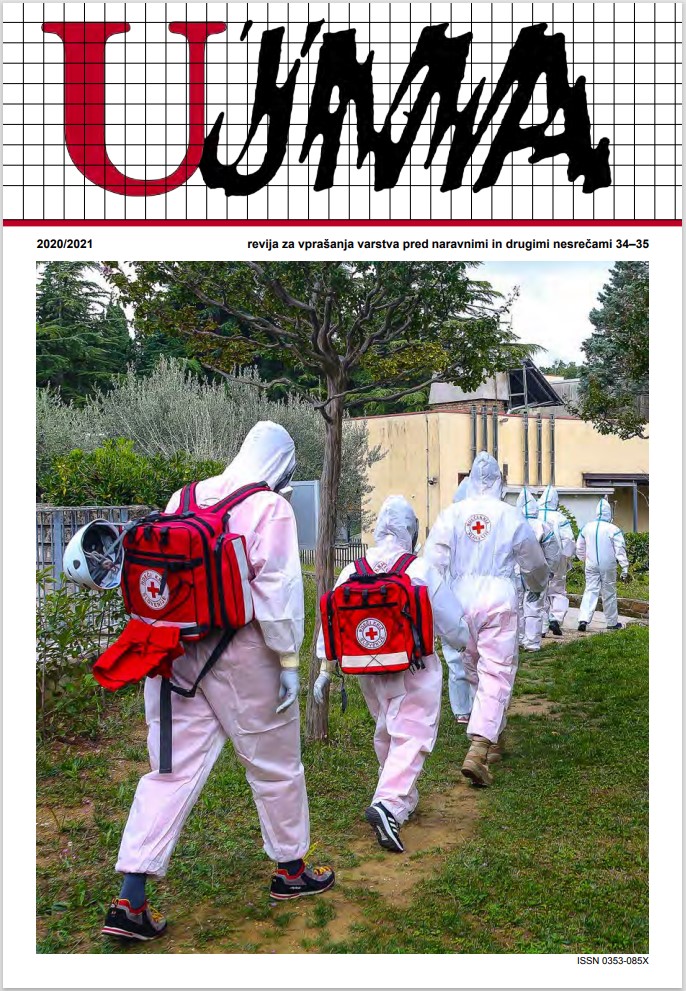GASES IN KARST CAVES AS A SOURCE OF HAZARD TO HUMAN
Abstract
The subterranean environment of karst caves has special climatic characteristics that depend, among other things, on the spatial location of the cave and the arrangement of the underground passages. These factors strongly influence the specific temperature, humidity and air movement in the caves. Due to natural causes or human activities, cave air may contain higher concentrations of gases that pose a hazard to humans. The purpose of this paper is to briefly present the specifics of the cave climate; to present the results of a survey conducted among cavers; to give detailed information on previous accidents; to present the characteristics of dangerous gases in caves; and to summarize some basic measures to avoid dangerous situations when visiting caves.
References
Ahčan, U., 2008. Celostna obravnava opeklinskih poškodb. V: Ahčan, U., Slabe, D., Šutanovac, R. (uredniki), Prva pomoč: priročnik za bolničarje. Rdeči križ Slovenije, Ljubljana, 93–104.
Alberta: Agriculture, Food and Rural Development. 2004. Methane (CH4) Safety. https://www1.agric.gov.ab.ca/$department/deptdocs.nsf/all/agdex9038/$file/729-2.pdf?OpenElement&fbclid=IwAR1kqzolBzj46xk1fyTuQULkl3dsQiYdDI8LlIcnVLbVhEPQ33HIycI7v_c, 8. 6. 2021.
Albreht, Š., Jenko, E., Mihalič, K., Pogačar, E., Posavec, A., Zakrajšek, M., 2018. Prva pomoč v jamarstvu. Ljubljana. Jamarska zveza Slovenije.
ARSO, 2002. Radioaktivnost v okolju. https://www.arso.gov.si/varstvo%20okolja/poro%C4%8Dila/poro%C4%8Dila%20o%20stanju%20okolja%20v%20Sloveniji/radioaktivnost.pdf, 12. 3. 2021.
Cigna, A. A., 2004. Climate of caves. V: Gunn, J. (urednik), Encyclopedia of Caves and Karst Science. Fitzroy Dearborn, New York, 467–475.
European Industrial Gases Association, 2017. Carbon Dioxide Physiological Hazards. https://www.eiga.eu/index.php?eID=dumpFile&t=f&f=3282&token=fe8e3399018ad935dd2c8600f03a43e1e587dab3, 2. 4. 2021.
Field, M. S., 2007. Risks to cavers and cave workers from exposures to low-level ionizingaradiation from222Rn decay in caves. Journal of Cave and Karst Studies, 69(1), 207–228.
Freitas, C. R., Littlejohn R. N., Clarkson, T. S., Kristament, I. S., 1982. Cave climate: Assessment of airflow and ventilation. Journal of Climatology, 2(4), 383–397.
Gabrovšek, F., Peric, B., 2006. Monitoring the flood pulses in the epiphreatic zone of karst aquifers: The case of Reka river system, Karst Plateau, SW Slovenia. Acta carsologica, 35(1), 35–45.
Gams, I., 2004. Kras v Sloveniji v prostoru in času. Ljubljana, Založba ZRC.
Garogalo, P. S., Friecker, M. B., Günther D., Forti, P., Mercuri A.-M., Loreti M., Capaccioni B., 2010. Climatic control on the growth of gigantic gypsum crystals within hypogenic caves (Naica mine, Mexico)? Earth and Planetary Science Letters, 289, 3560–569.
Goldstein, M., 2008. Carbon Monoxide Poisoning. Clinical, 34(6), 538–542.
Gregorič, A., Vaupotič, J., Šebela, S., 2013. The role of cave ventilation in governing cave air temperature and radon levels (Postojna Cave, Slovenia). International Journal of Climatology, 34, 1488–1500.
Greiner, T. H., 1997. Carbon Monoxide Concentrations: Table. https://www.abe.iastate.edu/extension-and-outreach/carbon-monoxide-concentrations-table-aen-172/, 6. 4. 2021.
Gunn, J., 2004. Radon in caves. V: Gunn, J. (urednik), Encyclopedia of Caves and Karst Science. Fitzroy Dearborn, New York, 1318–1322.
Kataster jam Jamarske zveze Slovenije. 2021.
Kocijančič, A., Mrevlje, F., Štajer, D., 2005. Interna medicina. Ljubljana. Littera picta.
Merela, M., 2016. Jamarska reševalna služba Slovenije – ekipa za širjenje ožin ob nesreči v jami. Ujma, 30. 291–299.
Mihevc, A., 2018. Ice caves in Slovenia. V: Perşoiu, A., Lauritzen, S.-E. (urednika), Ice Caves. Elsevier, Amsterdam, 691–703.
National Research Council, 2008. Acute Exposure Guideline Levels for Selected Airborne Chemicals: Volume 6. Washington, The National Academies Press.
Occupational Safety and Health Administration, 2021. Hydrogen Sulfide. https://www.osha.gov/hydrogen-sulfide, 5. 4. 2021.
Palmer, A. N., 2007. Cave meteorology and internal weathering. V: Palmer, A. N., Cave Geology, Cave Books, Dayton, 324–346.
Pässler, P., Hefner, W., Buckl, K., Meinass, H., Meiswinkel, A., Wenicke H. J., Ebersberg, G., Müller, R., Bässler, J., Behringer, H., Mayer, D., 2008. Acetylene. V: Ullmann‘s Encyclopedia of Industrial Chemistry. Willey-VCH, Weinheim, 1–52.
Primc, J., 1978. Tragedija jamarjev v Bilpi. Dolenjski list, 22, 1 in 23. http://www.dlib.si/stream/URN:NBN:SI:DOC-OQK9JNBF/6d3a588d-a133-4823-9868-05518eab3352/PDF.
Savnik, R., 1960. Prvi raziskovalci našega kraškega podzemlja. Naše jame, 2, 16–24.
The National Institute for Occupational Safety and Health, 2021a. Nitric dioxide. https://www.cdc.gov/niosh/npg/npgd0454.html.
The National Institute for Occupational Safety and Health, 2021b. Nitric oxide. https://www.cdc.gov/niosh/npg/npgd0448.html
Downloads
Published
Issue
Section
License

This work is licensed under a Creative Commons Attribution-NonCommercial-NoDerivatives 4.0 International License.
The articles are made available to the public under Creative Commons Attribution-NonCommercial-NoDerivatives 4.0 International (CC BY-NC-ND 4.0).


